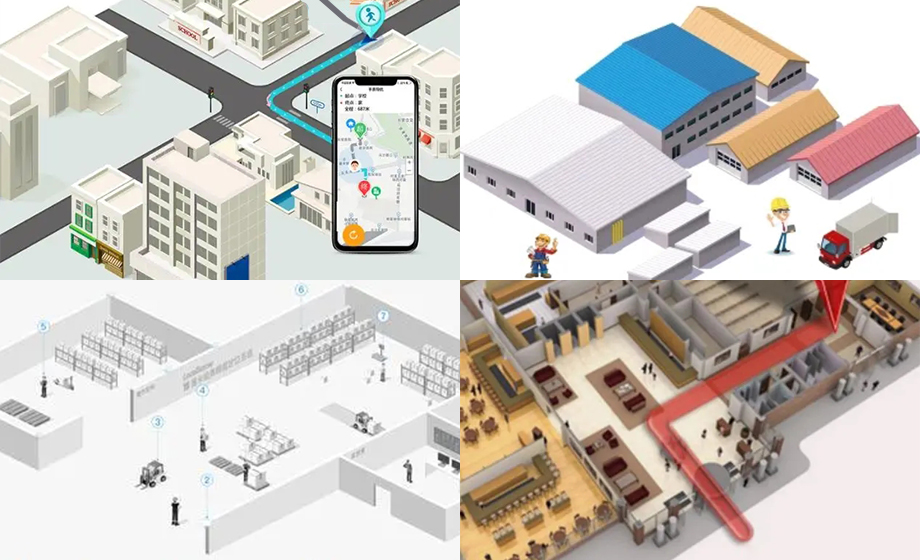With the continuous improvement of people's demand for accurate positioning, positioning technology is gradually moving towards high precision and convenience. Mobile phone UWB positioning module is undoubtedly a future disruptor in the field of positioning, so in this article, we will introduce the concept, working principle and advantages of mobile phone UWB positioning module in detail, for you to interpret this emerging mobile positioning technology.

First, what is the mobile phone UWB positioning module?
UWB (Ultra-Wideband) technology is a wireless communication technology that can use very short pulses or large bandwidth signals for communication or positioning. For indoor positioning and harsh environment positioning, its positioning accuracy is higher than Wi-Fi, Bluetooth and other traditional positioning technology, positioning error can be controlled within 10 cm, very suitable for a wide range of wireless applications.
Mobile UWB positioning module is a scheme that applies UWB technology to mobile phones to achieve high-precision indoor or outdoor mobile positioning. Through the design of miniaturized modules, this function is easily integrated into your mobile phone.
Second, what is the working principle of mobile phone UWB positioning module?
The UWB positioning module of the mobile phone can calculate the distance between the receiving end and the sending end by transmitting and receiving radio waves, using the time difference, and carry out the final positioning through multi-point positioning.
UWB technology uses short time domain pulse and ultra-wideband signal, can transmit a large amount of data, has the characteristics of high speed, high precision and strong anti-interference ability, so it is suitable for large-scale applications in high-density indoor, urban and field multi-environment complex scenes.
Third, what are the advantages of mobile UWB positioning module?
1. High positioning accuracy, small error
The positioning accuracy of the mobile phone UWB positioning module can reach less than 10 cm, which can still ensure a very low error rate in a high-density indoor environment, and provide users with more accurate positioning services, especially for scenarios requiring high-precision indoor positioning (such as hospitals, shopping malls, etc.), which is of great significance.
2. Supports multi-device co-location
The UWB technology has high transmission rate and wide frequency band, and can support the cooperative positioning of multiple devices. Even if the user is in a multi-storey building or even an urban area, it can quickly position the equipment accurately, with the base station, controller, etc., forming a complete solution from the starting point to the end point to achieve seamless connection.
3. High security
The data transmission of UWB technology has a high degree of security, which can avoid insecure factors such as information leakage and signal interference, and protect the security of user data. Compared with popular wireless technologies such as Bluetooth and Wi-Fi, UWB technology has better privacy protection and higher transmission security.
4. Seamlessly integrate mobile apps
Mobile UWB positioning module has a high degree of reliability and stability, and can be closely integrated with various mobile applications. For example, in the field of new retail, product positioning can be realized through the mobile UWB positioning module, which can easily and quickly realize the functions of commodity shopping guide, real-time preferential treatment, and order initiation, so as to improve user experience and shopping efficiency.
In addition, in indoor navigation, accurate positioning, indoor sports and other fields, mobile phone UWB positioning module has a wide range of application prospects, and has excellent commercial value.
Fourth, what is the market prospect of mobile UWB positioning module?
Mobile location technology has developed rapidly in recent years, especially among millennials and Gen Z users. In this context, mobile phone UWB positioning module will become the future development trend, with broad market prospects.
According to the data of market forecasting institutions, the global UWB market size will reach 6.82 billion US dollars in 2025, of which the market share of mobile UWB positioning modules will continue to expand. Especially in smart home, new retail, indoor navigation, car networking and other fields, mobile UWB positioning module will have a wider range of application scenarios, providing enterprises with more opportunities for innovative development.
Five, how to optimize the use of mobile phone UWB positioning module effect?
1. Maintain a well-positioned environment
When positioning, the user should ensure that the surrounding environment is relatively static, reduce the influence of interfering factors, and ensure accuracy and stability.
2. Enhance signal reception capability
In the indoor environment where the signal reception is weak, the user can enhance the signal reception ability and improve the positioning accuracy by increasing the number of base stations and improving the sensitivity of positioning reception.
3. Effectively manage mobile phone location permissions
For applications with privacy issues, users should pay attention to scientific and effective management of mobile phone positioning rights to prevent the risk of information leakage.
4. Check equipment maintenance regularly
The positioning device, like other smart devices, also needs regular maintenance, such as battery replacement and hardware overhaul, to ensure the normal operation of the device and extend its service life.
Vi. Conclusion
The continuous progress of electronic technology has made our lives more convenient and faster. The emergence of mobile UWB positioning module technology provides more accurate and portable mobile positioning solutions for people, and has wide application value and development prospects.
Because of this, we should actively promote and apply this technology, provide more imaginative space for the innovative development of the industry, and jointly promote the further progress of wireless communication technology.



